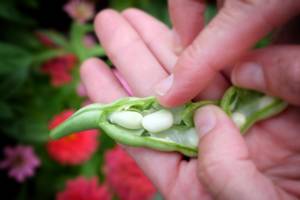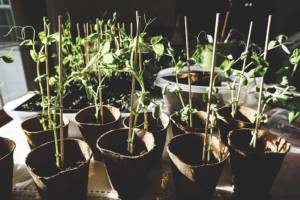Over the last few years urban farming has become increasingly popular.
And really, why shouldn’t it?
Urban farming is a great way to create useful space in packed cities. More importantly, it offers the perfect way to get high quality, organic produce into the city, without it suffering any of the normal declines associated with long distance transport.
However, when it comes to urban farming, there are a few unique problems.
Like wind, for example.
How does wind affect plants?
One of things we need to note is that when it comes to urban farming, wind is not always a bad thing.
In fact, small amounts of wind can help your saplings grow up to be sturdier plants. Similarly, moderate wind exposure increases the supply of carbon dioxide to your plants, which may improve growth.
However, there is a downside.
High winds can rip the leaves from your plants, while dense planted canopies can suffer abrasion damage from constant rubbing. Soil particles lifted into the air by wind can damage plants. And of course, strong winds can physically knock plants over (Cleugh, 1998).
So, if you have ever wondered “can wind damage plants”, the simple answer is yes, they can.
How does wind affect plant size?

What about plant size?
In general, plants exposed to large amounts of wind during growth phases tend to be smaller and more compact, with thicker stems and larger roots, than those who are not. They may also develop smaller leaves, and thinner, more flexible leaf stems (Gardiner, 2016).
With this in mind, wind can affect plant size – and in general, the stronger the wind the plant is exposed to, the smaller it will grow.
While this may make for a sturdier pant, it is not ideal for your urban garden, as it will directly impact your yield.
Wind resistant fruits and vegetables
With all this information, it is important to note that when it comes to wind not all plants are created equal – in fact, some are much more wind resistant than others.
Which is why you may want to look into wind resistant fruits and wind resistant vegetables for your urban garden.
So, what fruits and vegetables are most wind resistant, and which ones are the least wind resistant?
Most wind resistant fruits and vegetables
Some of the best wind tolerant plants for your urban garden include:
- Blueberries
- Red currants
- Raspberries
- Strawberries
- Lemon
- Pomegranate
- Arugula
- Bok choy
- Beans
- Carrots
- Chard
- Garlic
- Kale
- Leeks
- Lettuce
- Potatoes
- Zucchini
- Tomatoes
With these, almost all herbs offer great options as they typically grow nice and low to the ground.
Least wind resistant fruits and vegetables
What about some of the least wind resistant fruits and vegetables?
In general, most large fruits trees don’t do all that well in the wind. This includes:
- Apples
- Peaches
- Plums
- Nectarines
- Bananas
In terms of vegetables, it is in your best interest to avoid:
- Peppers
- Chillies
- Watercress
- Radishes
How to design farm around wind with limited space

When it comes to designing a farm in a windy area, and with limited space – well, let’s just say things can get a little tricky.
But there are a couple of steps that you can take to make it work.
First are foremost, you want to make sure that you maximize every piece of space you have available for planting. This means less walking room, and a whole lot of planting room.
With this, you want to try and make sure that you organize everything as well as possible. All your plants should be evenly spaced, and in nice, even rows. And if you are in a windy area, you want to make sure that the most densely planted area is the centre of the garden – where the wind will have less impact.
Secondly, within the central component of your garden, choose plants that can be grown on a trellis (some of my favorites are tomatoes and beans). By growing some plants vertically, you will create a heap more room.
Thirdly, introduce some raised garden beds. This essentially doubles your space by providing an additional layer to plant upon.
And finally, don’t be afraid to use pots. Pots offer a great way to grow smaller plants, and by using raised shelving, you can grow a huge amount with very limited space.
Plant wind protection tips
A common question I get when it comes to urban gardens, is “How do Urban Rooftop Farms handle wind?”
And trust me, this is a good question – because it can be a lot easier said than done.
As a result, I wanted to offer some tips for rooftop farms with a lot of wind.
These tips really demonstrate how to protect plants against wind to limit wind damage. This is integral if you have any intention of starting a rooftop garden.
So, without further ado, my favorite windy garden solutions.
Planting tomatoes more densely
I mentioned briefly above that tomato plants can offer a great option when it comes to windy areas – but there is a bit of a caveat here.
They need to be grown quite close together.
Tomato plants are unique in the fact that they need wind to pollenate (rather than bees). However, if the wind is too damaging, it can have a deleterious effect on the growth and pollination of the plant.
If you choose to plant them quite densely (one plant for every 2-4 square feet of soil), then they act as wind break for one another, mitigating the negative effects of the wind.
Moreover, this can improve pollination.
Netting fruit trees
Netting fruit trees has been common practice for decades as a way to stop insects and birds from eating your hard-grown fruit.
However, netting offers one other key benefit – yep, you guessed it – it protects your plants from the wind.
By using thicker netting, and completely covering the entire tree (stem and all), you can seriously mitigate the negative effects of the wind on their growth.
Planter hoops
Much like the point above, there is also some merit in placing some hoop houses (sometimes called ‘row covers’) over your planters.
This will protect the plants from the wind, while also keeping nasty bugs at bay.
What more could you want?
As an added bonus, this can easily be done on each level of any multilevel plantar box, meaning that it can easily be integrated with your space saving methods.
Covering with plastic during storms
Now, this tip here isn’t something that you want to do all the time – but it is still extremely important.
When it comes to wind damage, a storm is your worst nightmare. Wind speeds climb through the roof, and the damage they can incur on your entire garden becomes astronomical.
Which is why you want to have some dense plastic on hand.
If you know a storm is approaching, it is in your best interest to cover your entire garden in plastic. With this, you want to make sure that you anchor it down tightly, and pull it as taught as possible – it is this step that will stop the wind.
Take Home Message
Urban farming is one of the most enjoyable (and rewarding) things you can do to take the next step to living a healthy, organic lifestyle.
But the hardest part is making sure that you are not impacted by the wind – which is exactly why I wanted to provide some helpful tips in this article!
References
Cleugh, H. A., J. M. Miller, and M. Böhm. “Direct mechanical effects of wind on crops.” Agroforestry Systems 41.1 (1998): 85-112.
Gardiner, Barry, Peter Berry, and Bruno Moulia. “Wind impacts on plant growth, mechanics and damage.” Plant Science 245 (2016): 94-118.



Add Comment